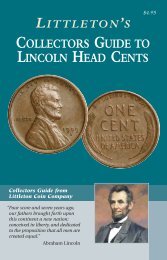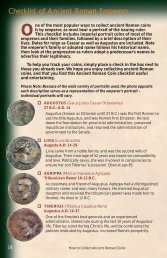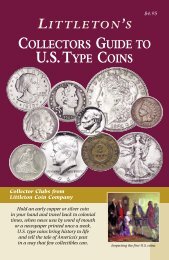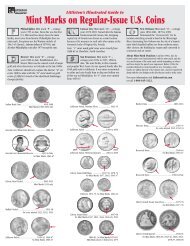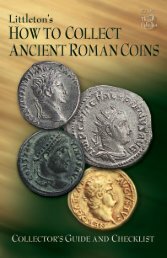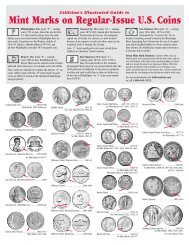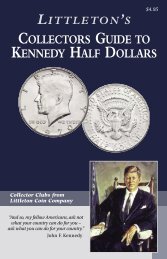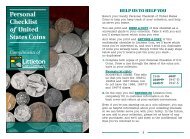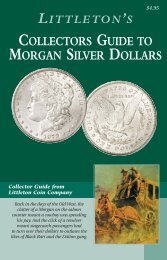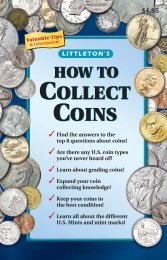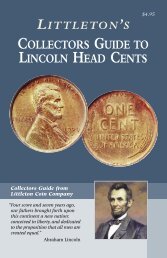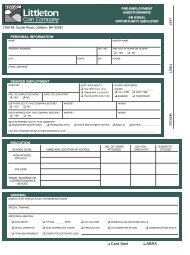Collecting Paper Money - Littleton Coin Company
Collecting Paper Money - Littleton Coin Company
Collecting Paper Money - Littleton Coin Company
Create successful ePaper yourself
Turn your PDF publications into a flip-book with our unique Google optimized e-Paper software.
frequently asked questions about u.s. paper money<br />
{<br />
4<br />
Frequently Asked Questions<br />
about U.S. <strong>Paper</strong> <strong>Money</strong><br />
1. What makes paper money valuable?<br />
Age does not always make paper money valuable,<br />
though it is usually a factor. In fact, some 1861-65<br />
Confederate States of America notes from the<br />
Civil War era cost much less than some large-size<br />
U.S. notes from the early 1900s. Value, as for most<br />
items, is determined by the interrelated factors of<br />
scarcity, condition and demand.<br />
For example, if many more notes of an earlier<br />
series have been produced than a later one, there<br />
may be far more older notes that survive. It also<br />
depends on how many of each have been saved,<br />
and their condition. Condition is important in determining value. An<br />
Uncirculated piece may be worth many times more than an average circulated<br />
note of the same series and denomination.<br />
Demand is also a major factor. Some types of paper money, such as<br />
large-size Silver Certificates and Legal Tender Notes, are more popular than<br />
others. So, with more collectors seeking the same notes, prices will be affected.<br />
2. Why is paper money collecting so popular?<br />
<strong>Paper</strong> money is an exciting hobby because notes are colorful, informative,<br />
and attractive. You can learn about art, economics, and even technology by<br />
studying paper money and the stories behind it. Plus, it’s also a genuine<br />
artifact of the past, capturing exciting areas in American and world history. As<br />
far as the hobby itself, the serious, organized collecting of paper money dates<br />
back to the early to mid-20th century. Today, it’s one of the fastest growing<br />
areas of numismatics.<br />
3. When was the first paper money issued?<br />
<strong>Paper</strong> was invented by the Chinese around A.D. 105, so it’s not surprising that<br />
they produced the first paper money! Although no examples exist today, a<br />
manuscript tells of a paper note issued in China around A.D. 650.<br />
The oldest existing collectible paper note dates from 1368, and is from<br />
the Ming Dynasty. This note is huge, measuring approximately 9˝ x 13˝. Its<br />
paper was made from the inner bark of the mulberry tree. The first true<br />
European bank note was issued in 1661 by a private bank in Sweden, while<br />
the first paper money in the New World was issued in 1690 in Massachusetts<br />
Bay Colony (one of the earliest New England settlements in present-day<br />
Massachusetts).<br />
4. How many different types of U.S. <strong>Paper</strong> <strong>Money</strong> are there?<br />
From the first Colonial Note printed in 1690 by the Massachusetts Bay Colony<br />
to the latest series of revised federal currency (starting with the Series 2004<br />
Andrew Jackson $20 Federal Reserve Note), many types of paper money have<br />
been issued in the course of our nation’s history.<br />
|<br />
Drying large-size bills<br />
at the U.S. Treasury<br />
www.littletoncoin.com<br />
{littleton coin company



